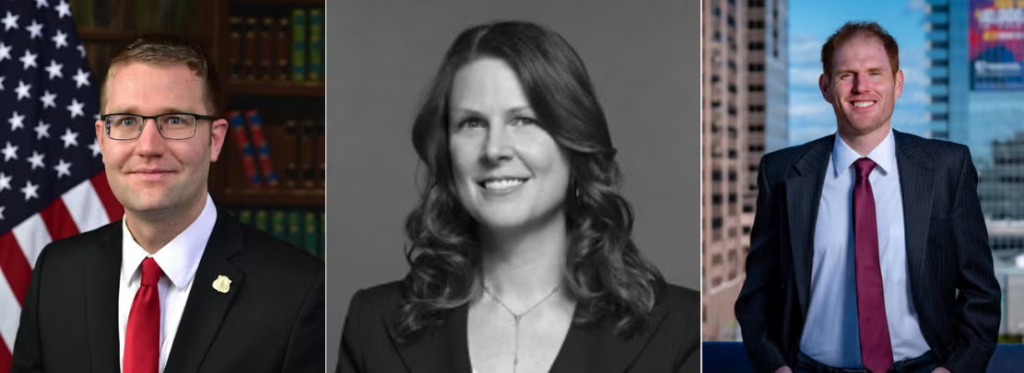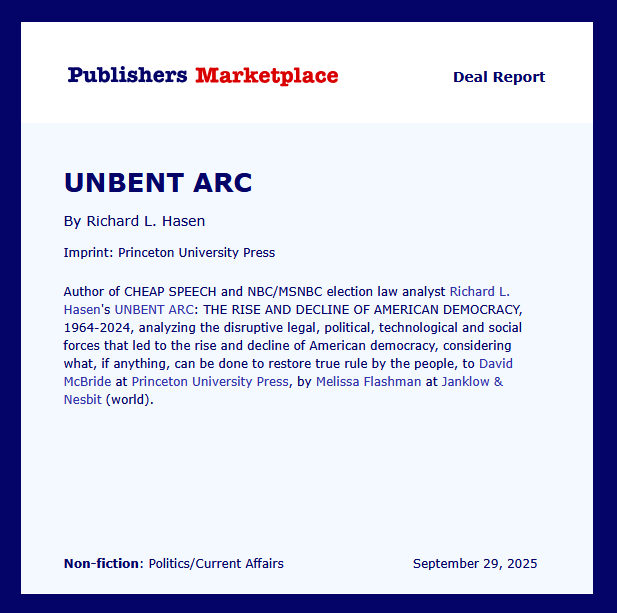Nate packs a lot of data and important observations into this talk, which was held on October 7, 2025. Watch:
Category Archives: The Voting Wars
Very Excited to Announce My New Book Project, “Unbent Arc: The Rise and Decline of American Democracy 1964-2024”
The Underpants Gnomes Are Coming For Our Elections
Over at TPM, I wonder whether a brilliant bit of South Park satire may shed some helpful light on the magical wishcasting of unilateral federal executive control over electoral process.
Walter Olson: “CIS kicks voter registration groups out of naturalization ceremonies”
Walter at his Substack:
An Aug. 29 policy statement from U.S. Citizenship and Immigration Services, the federal agency, says the agency will from now on bar nonpartisan groups such as the League of Women Voters from offering voter registration services at the end of CIS-hosted naturalization ceremonies.
The League of Women Voters, deploring the move, says it’s been offering voter registration at naturalization ceremonies “for decades.”
Thanks for reading! Subscribe for free to receive new posts and support my work.Subscribe
If CIS has alleged that this process has been abused in some way, I’ve missed it.
Under the new policy, CIS will still invite state and local election agencies — and only them — to offer voter registration after ceremonies. The League, however, says those agencies often lack capacity to send personnel to the events and have been grateful for the help….
The new policy applies to so-called administrative naturalization ceremonies in which CIS officials are present. That includes not only those held at CIS facilities but also, so far as I can see, those at off-site locations that civic or government groups have made available for the occasion, such as civic centers and other public buildings, military bases, sporting events, fairs and so forth. CIS can and does place extensive conditions on the government and civic groups that make these venues available, so I assume it can probably impose its policy, or something close, in off-site locations that are not on CIS’s own property.
On the other hand, if I’m reading the newly revised CIS policy manual correctly, the new policy does not extend (see Footnote 1) to “judicial” naturalizations in which a federal, state, or local judge administers the oath of allegiance at a courthouse or elsewhere. If so, nonprofits can still register voters at those venues with host permission….
Announcing the Safeguarding Democracy Project’s Fall Lineup of Events and Webinars, Focused on the Fairness and Integrity of the 2026 Midterms
The Risk of Federal Interference in the 2026 Midterm Elections

Tuesday, September 16, 12:15pm-1:15pm PT, Webinar
Register here.
Ben Haiman, UVA Center for Public Safety and Justice, Liz Howard, NYU Law Brennan Center for Justice, and Stephen Richer, Ash Center for Democratic Governance and Innovation, Harvard Kennedy School
Richard L. Hasen, moderator (Director, Safeguarding Democracy Project, UCLA)
UCLA School of Law is a State Bar of California approved MCLE provider. This session is approved for 1 hour of MCLE credit.
Lessons from the 2024 Elections for 2026 and Beyond: A Conversation with Nate Persily

Tuesday, October 7, 12:15pm-1:15pm PT, Room 1337 UCLA Law and online
Register here for in-person. Lunch will be provided.
Register here for Webinar.
Richard L. Hasen, Director, Safeguarding Democracy Project, UCLA and Nate Persily, Stanford Law School
UCLA School of Law is a State Bar of California approved MCLE provider. This session is approved for 1 hour of MCLE credit.
Redistricting and Re-Redistricting Controversies and the 2026 Elections

Thursday, October 16, 12:15pm-1:15pm PT, Webinar
Register here.
Guy-Uriel Charles, Harvard Law School, Moon Duchin, Director, Data and Democracy Research Initiative, University of Chicago, Michael Li, NYU Law Brennan Center for Justice, and Nicholas Stephanopoulos, Harvard Law School.
Richard L. Hasen, moderator (Director, Safeguarding Democracy Project, UCLA)
UCLA School of Law is a State Bar of California approved MCLE provider. This session is approved for 1 hour of MCLE credit.
Media, Social Media, and the Changing Election Information Environment in 2026

Thursday, October 30, 12:15pm-1:15pm PT, Webinar
Register here.
Co-sponsored by the Institute for Technology, Law & Policy
Danielle Citron, UVA Law School, Brendan Nyhan, Dartmouth College, and Amy Wilentz, UCI Emerita
Richard L. Hasen, moderator (Director, Safeguarding Democracy Project, UCLA)
UCLA School of Law is a State Bar of California approved MCLE provider. This session is approved for 1 hour of MCLE credit.
The Supreme Court, the Voting Rights Act, and the 2026 Elections

Tuesday, November 18, 12:15pm-1:15pm, PT, Webinar
Register here.
Ellen Katz, University of Michigan Law School, Lenny Powell, Native American Rights Fund, and Deuel Ross, Legal Defense Fund
Richard L. Hasen, moderator (Director, Safeguarding Democracy Project, UCLA)
UCLA School of Law is a State Bar of California approved MCLE provider. This session is approved for 1 hour of MCLE credit.
The TBD details on California’s redistricting special election
Justin here. Today, California Gov. Newsom announced what he’d been foreshadowing for a while now — an effort to seek voters’ approval for new congressional district lines in a Nov. 4 special election. (Rick noted the border patrol “escort” for the press conference. I can’t help note that the Japanese American National Museum – for those who haven’t been, it’s got a tremendously powerful series of exhibits on the WWII internment — is a little on the nose as a backdrop for a militarized show of force at a political event.)
The exact contours of the legislative package to make the redistricting initiative happen probably won’t be crystal clear until the legislature gets back next week. But among the pieces I’ll be watching:
- Timing. Current law seems to say that the governor can call a special election 148 days out. The legislature, of course, can change that law — and it’ll have to in order to hit a November 4 special election target (82 days away from today). (That timing provision can be changed by statute, I believe – the date change doesn’t have to itself go on the ballot.) I’ll be looking for whether this is a one-time-only change or whether there are more general conditions for the exception.
(Update: Derek Mueller reminds me that there’s another statute that doesn’t regulate when an election can be scheduled, but does say that the legislature can only put an initiative on the ballot for a scheduled election if that election is at least 131 days away. That statute would also need amending to run this Nov. 4 – and I’ve got the same questions as above.) - Funding. Part of the reason for leaving time before a special election is to give election officials the runway they need to run the thing. As Doug Chapin used to hammer home on the regular — fast, accurate, cheap: pick any two. This schedule will be fast, and the results have to be accurate. I’ll be looking to see who’s picking up the extra tab for the pre-election prep overtime.
- Substance. The best reading of the state constitution is that maps are drawn by an independent commission, once per decade. That authority can be changed with a ballot initiative. But the reporting says that Newsom also plans to “put a new map” in front of voters on Nov. 4. The change to authority has to be in the constitution, but I imagine the map would be an initiated statute (and not itself constitutionalized). There’s nothing inherently weird about having both a constitutional change and a statutory change in the same measure — the proposition to put the commission in place in the first instance combined the two. But a single initiative to both change the process and pass a new specific map has some risks under the state’s single-subject rule. Two separate initiatives create questions about what happens if the electorate passes one but not the other. I’ll be looking to see how the package resolves those questions.
- Additional constraints. Article XXI is the part of the state constitution that gives authority to the commission. It also has a bunch of other constraints, procedural and substantive. If the new initiative is effectively a temporary contingent carveout, how temporary? What’s the threshold of the contingency? How complete a carveout? Texas has essentially no state rules for drawing congressional districts – the only rules are the few rules in federal law. For its response, does California do the same?
- Additional triggers. Newsom has said that California will respond to Texas in the maps he puts forward. I’m told that California and Texas aren’t the only two states in the Union. If another state says that it’s re-redrawing its maps to respond to California, does the initiative include provisions for re-re-redrawing the maps to respond to the response? Does the initiative include a provision allowing for later legislative amendment of the (presumably statutory) map?
Lots still TBD here.
“Voting Rights Litigation: A Blueprint for Strategic Investment in America’s Polarized Political Landscape”
I’m can’t-look-away-from-the-train-wreck fascinated by the guidance on how investors can profit off of civil rights struggles:
The Supreme Court’s 2013 Shelby County v. Holder decision, which gutted the Voting Rights Act’s (VRA) preclearance protections, has unleashed a wave of litigation across the U.S. While the ruling aimed to reduce federal oversight, it instead ignited a firestorm of legal battles over voting access and redistricting. For investors, this isn’t just a civil rights story—it’s a roadmap to sectors primed for growth in racially polarized states. Let’s dissect the opportunities and risks.
“Republicans push for election skeptics to oversee Atlanta-area voting”
The Atlanta Journal-Constitution covers a distressingly familiar fight that’s now hit the courts:
The Democrat-controlled Fulton County Commission in May voted along party lines to reject the GOP’s nominees. That led the Georgia Republican Party to sue earlier this month contending the commission is required to accept the party’s choices.
. . .
In both Fulton and DeKalb, the Republican and Democratic parties nominate representatives for four out of five seats on the election boards, which are then confirmed or rejected by the county commission or chief judge. The tiebreaking fifth seat in Fulton was nominated by the commission chairman and in DeKalb by the other four members.
. . .
Fulton Commissioner Marvin Arrington, a Democrat, said he had a responsibility to oppose the Republican Party’s nominees: Jason Frazier, who has challenged the eligibility of thousands of voter registrations, and Julie Adams, an incumbent election board member who voted against certifying last year’s primary election.
. . .
Georgia Republican Party Chairman Josh McKoon said Fulton is denying Republican representation on the county election board. The existing Republican appointees to the board will continue to serve until their replacements are confirmed.
“Jocelyn Benson vs. GOP: What is this fight over Michigan election manuals really about?”
I agree with Votebeat’s topline description of the latest tiff in the Wolverine State:
Michigan’s top election official is locked in a clamorous legal battle with Republican lawmakers over access to election training materials, a conflict that likely has less to do with policy than politics — and the coming race for governor.
“This Year’s Election Bills Focus On Citizenship, Ranked Choice Voting”
NCSL’s election bill roundup notes the shift of this year’s crop:
With most legislatures having adjourned, the number of election bills introduced was 3,160, with 331 of them enacted into law across 43 states, according to NCSL tracking. Although this is a significant increase from the 2,017 bills NCSL tracked at the same point in the 2024 session, the number of enactments last year—218—was only slightly off this year’s count. It’s common to see an increase in election-related legislation following a presidential election, and this has certainly proved true in 2025.
With election bills introduced on a wide range of subjects, some notable trends and consistently popular topics came to the fore. Among a range of enactment trends, citizenship and voter identification continued their 2024 resurgence as areas of high legislative interest, bans on ranked-choice voting continue to increase, and the standardization of election dates stood out.
More evidence of the Trump mobilization of lower-frequency voters
The NYT headline is “If Everyone Had Voted, Harris Still Would Have Lost.”
Which, of course, is impossible to know, unless you assume that demographics is inevitably destiny.
But the broader point of the outcome of this new Pew study is one a few of us have been noting for a while: Trump had/has significant appeal among a set of voters less likely to vote frequently (including a larger component of racial and ethnic minorities than his previous runs). That likely means that efforts to increase turnout may favor Republicans, at least in some areas.
And because less frequent voters are hardest hit by new barriers, I’ve wondered quite a bit whether we’ll start to see the fact of Trump’s appeal to less frequent voters reflected in shifting incentives for election administration, fighting quite a bit of what seems to be received conventional wisdom.
“North Carolina to send mailers to some 200,000 voters asking for missing registration info”
The AP has the report, following on the DOJ’s case I’ve been blogging.
This report has a piece of info that’s new to me, though:
About half of the 200,000 affected voters would be limited to casting provisional ballots until they provide the information to the state, [NC Board of Elections Executive Director] Hayes said.
It’s my understanding that all of the voters here were validly registered under state law, which means that the voters were necessarily validly registered under federal law. (And that’s independent of whether the state itself had sufficiently complied with federal law.)
Unless the 100,000 people in question are new voters under HAVA who haven’t yet shown any ID, I’d be very interested to know the legal basis for forcing them to vote provisionally.
“Republican majorities named to North Carolina’s 100 local election boards”
The News & Observer reports that the State Auditor has appointed a new slate of county election officials, after North Carolina shifted responsibility for those assignments from the Democratic Governor to the Republican State Auditor.
The law making that change is still in litigation: a state trial court found that the law was unconstitutional, but that decision has been paused pending appeal. (A related appeal on transferring appointment powers for other state offices is being heard by the state court of appeals today.)
“Nevada GOP governor vetoes voter ID bill that he pushed for in a deal with Democrats”
Nevada Republican Gov. Joe Lombardo unexpectedly vetoed a bill on Thursday that would have required voters in the swing state to show a photo ID at the polls — a conservative priority across the country and something that has long been on the governor’s legislative wish list.
The move brings a dramatic end to one of the legislative session’s most surprising outcomes: A bipartisan deal that combined the requirement for voter identification with a Democratic-backed measure to add more drop boxes for mail ballots that Lombardo had initially vetoed.
The bill came together in the final days of the session and passed mere minutes before the Democratic-controlled Legislature adjourned just after midnight on June 3. Lombardo had been expected to sign it.
In his veto message, Lombardo said he “wholeheartedly” supports voter ID laws but that he felt the bill fell short on addressing his concerns about ballots cast by mail, because such ballots could still be accepted “solely on the basis of a signature match” under the bill….
